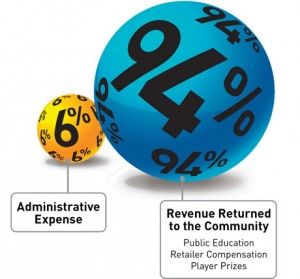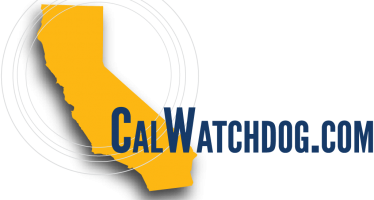CA Lottery: State’s cash cow
Sept. 27, 2012
Katy Grimes: I am not sure why Californians are faced with two tax increase measures this November, ostensibly to help fund California’s starving public educational system.
The California Lottery, which was sold to voters as a way to help fund California’s public education system, is a cash cow, and rakes in billions of dollars every year. But what actually makes it to schools amounts to about $132 per student.
There are Lottery regulars who spend more than that every month on lottery tickets.
While every dollar helps, California’s public schools are in really bad shape; more money will not fix what ails them.
Prop 30 and Prop 38
Gov. Jerry Brown’s Proposition 30 raises sales tax on everyone, and increases the income tax on income of more than $250,000. Prop 30 would only add between $6 and $8 billion in additional tax revenue to the state’s coffers. And only $2.5 billion of that would go to education.
Proposition 38 will increase state income tax rates for nearly all Californians, and is expected to raise tax revenues of about $10 billion a year, according to Ballotpedia.
Lottery dreams
The California Lottery was sold to the state’s voters as a funding source for public education. Ahhh… I remember it well. “Our schools win too!” was the advertising slogan.
It was October of 1985 when the first lottery tickets went on sale. Californians went nuts with delusions of riches. A group of my friends had a lottery party where we had pooled money to purchase $100 worth of lottery tickets. At our “Scratchers Party,” libations flowed while we celebrated the ridiculousness of the lottery. Several volunteers scratched the 100 tickets to see if we had won.
Zip. Nada. But we had a fun party anyway, especially when the local news channel showed up to film us.
That was the last lottery ticket I ever purchased. I am not a big believer.
Proposition 37
The 1984 passage of Proposition 37, the California State Lottery Act of 1984, authorized the creation of a state lottery. But only 58 percent of California voters approved the initiative.
“Under the measure, we estimate that approximately 80 percent of the state’s share of the lottery revenues would go to K-12 schools, 13 percent would go to community colleges, 5 percent would go to the California State University, and 2 percent would go to the University of California,” The Legislative Analyst’s Office reported.
Is that what has happened?
The California Lottery has a 2012-13 annual budget of $4.83 billion. Of that, they claim that they generate more than $1 billion a year for education. They also claim that 94 percent of all lottery revenue goes back to the public, and 6 percent is used for administrative expenses. If this is accurate, then the lottery is an amazingly tightly run state agency, and should be the model for all state agencies.
“The California Lottery does more than provide our players with fun and excitement by continually offering new and different games to play. We also generate more than $1 billion a year for education,” the Lottery website states.
“The Lottery establishes a 3-year rolling Business Plan that sets goals and objectives to be met each fiscal year. We are continuously reviewing our performance based on short-term targets, throughout the organization, to ensure that we operate at maximum efficiency and can make course corrections during the fiscal period. Like other businesses, our performance review is critical in measuring our success and identifying areas of improvement. With consistent close examination of the Lottery’s performance, we are able to keep our promise to California by maximizing our contribution to education.”
Since its inception in October 1985, the Lottery claims to have provided more than $25 billion to California’s public schools.
At what cost to taxpayers? The agency has become a behemoth with a more than $4 billion annual budget.
The total cumulative contributions to schools 1985 to present:
K-12: $$19.2 billion
Community Colleges: $3.27 billion
California State University: $898 million
University of California: $535 million
Other public colleges and universities: $4.4 million
Misc. educational institutions: $40,138,316
The Certified Annual Financial Report for the Lottery reports the distribution of Revenues (in billions) for October 3, 1985 – June 30, 2011:
Prizes: $34.1
Retailer Compensation: $4.3
Direct Costs: $1.5
Operating Expenses: $3.0
Contributions to Education: $24.0
The CAFR also reports:
* The assets of the Lottery exceeded its liabilities at the close of the most recent fi scal year by $103 million.
* The California Lottery’s contribution to education increased $38.8 million over the last fiscal year. This is the eleventh consecutive year the Lottery will transfer over $1 billion to California’s public schools and colleges.
* In addition, the California Lottery paid out more than $1.9 billion in prizes to players and approximately $233.6 million in commissions, cashing bonuses, and other applicable fees to retailers.
* California Lottery sales revenue increased 13.1 percent, or approximately $397.6 million dollars over last fiscal year.
The idea that it takes money to make money may work in fundraising and the private sector. But in the world of government, the goal is rarely to make money or profit, it is to expand, grow, and create a larger agency.
An announcement today in the California Morning Report by the Lottery Commission reports that the commission is considering amending it’s $4.83 billion budget to reflect an additional $11.4 million in profits expected from a $2 billion Powerball game, and from Scratchers tickets.
The Lottery commissioners will be meeting today and tomorrow. The meeting agenda is here.
You can plug in your local school district here to see how much it has received from the lottery.
Related Articles
CalWatchdog Morning Read – January 3
Proposed ballot measure asks if state should take action it already took Kern County law enforcement under fire Did California
Assembly confirms Maldonado
APRIL 22, 2010 Today the Assembly voted 51-18 to confirm Senator Abel Maldonado for Lieutenant Governor. Back in February, the Assemblyfailed
Shock! Jerry more sensible than Meg on Prop. 23/AB 32
John Seiler: One of the weird things about the last gubernatorial debate is that Jerry Brown was more sensible on





